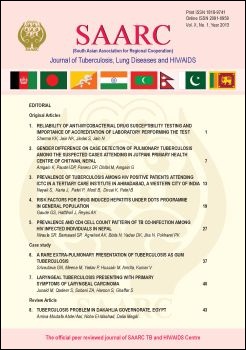Risk Factors For Drug Induced Hepatitis Under Dots Programme In General Population
DOI:
https://doi.org/10.3126/saarctb.v10i1.8673Keywords:
Chemotherapy, DOTS, Drug Induced Hepatotoxicity, TuberculosisAbstract
Background: Short course chemotherapy containing rifampicin and isoniazid in combination has proved to be highly effective under DOTS regimens in the treatment of tuberculosis, but one of its adverse effects is hepatotoxicity. Little however has been published regarding drug induced hepatitis (DH) under general programme conditions. In this study, we aimed to determine the prevalence of drug induced hepatitis and the risk factors associated with the development of hepatitis over a period of 5 years.
Methodology: This was a prospective study done from 2007 to 2011 in a tertiary care hospital. A total of 116 patients were included in the study that presented with hepatitis due to short course chemotherapy and were being treated under various categories of drug regimens. Fourty cases were being followed up and other 76 were seen at the hospital for the first time after the development of hepatitis. The diagnostic criteria’s for drug-induced hepatitis were made according to the ATS criteria’s. Various risk factors were analyzed for the development of DH.
Results: The prevalence of DH in the present study was 3.6%. It was observed that DH patients were older and their serum albumin levels were lower. Regular alcohol intake, more extensive disease radiologically and female gender were observed to be independent risk factors for the development of DH. No other risk factors analyzed had any signifi cant association with DH.
Conclusion: Of the various risk factors analyzed, advanced age, hypoalbuminaemia, regular alcohol intake and advanced nature of the disease were independent risk factors for the development of DH. The risk of hepatitis in the presence of one or more of these risk factors may be increased.
SAARC Journal of Tuberculosis, Lung Diseases & HIV/AIDS; 2013; X(1); 19-26
Downloads
Downloads
Published
How to Cite
Issue
Section
License
Copyright © SAARC Tuberculosis and HIV/AIDS Centre (STAC), all rights reserved, no part of this publication may be reproduced, stored in a retrieval system or transmitted in any form or by any means without prior permission of the STAC.





